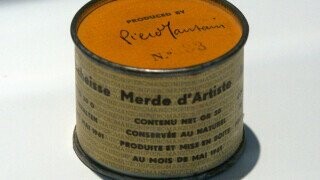An Artist's Poop Predicted NFT Hype 60 years ago

Crypto bros and investors have spent a lot of time presenting NFTS as a highly sophisticated techno-enhanced vehicle of value. NFTs, if you believe the hype, are the kind of new financial tool that's so far above our heads we need explanation after explanation after explanation. They're unique; they can't be exchanged for one another, and please, for the love of God, don't right-click, save them, or this whole scam falls apart.
As the NFT explosion has engulfed more and more of the internet, some buzzwords keep rising to the top, and chief among them is the idea of "provable scarcity." When you start wondering why anyone would pay thousands and thousands of dollars for a lightly modified JPEG of a lion, someone with a monkey avatar will explain to you that there are only ever going to be 1000 of those lions, so you gotta get them while they're hot. Because you know no more can be manufactured, you can be sure their value will go up over time. Maybe it's over your head because this is the new economy, web 3.0.

Which makes my favorite old artwork even funnier and more insightful than ever. Piero Manzoni was an Italian artist who made a name for himself in an era where the relationship between artists, art, and the art world was deeply in question. Works like Duchamp's Readymades were already asking what the value of art was, and Manzoni followed up with the question of what about the artist was important to art critics and patrons? In his early works, Manzoni sold his own breath and fingerprints, an obvious joke that begged people to pay absurd prices for things that are essentially useless.
Don't Miss
But Manzoni's masterwork came in 1961. In May of that year, Manzoni meticulously canned and labeled 90 pieces of his own poop. Manzoni made sure that each can was identical; they each had 30 grams of his, uh, finest work, and the can was made to appear like a common commodity besides an identifier number from 001 to 090.
I love a good poop joke as much as the next moron, but Manzoni wasn't joking around. He exhibited and sold his cans for huge sums and privately told his friends that the piece was meant as "an act of defiant mockery of the art world, artists, and art criticism." In August of 1962, Manzoni sold one of his 30g cans of turds for 30g of 18 karat gold. For Manzoni, this was part of the point-- by emphasizing the limited amount of his poop available, he was able to drive up the point to an obviously absurd point, where it was literally worth its weight in gold.

Sadly, Manzoni passed away not long after creating Artist's S**t. But the joke lives on. In 2007 one of his tins sold at Sotheby's for around $90,000. In 2016 another sold for almost $250,000. The price of the cans is always rising, making the joke funnier and funnier. And coinbase users could tell you why: there are only 90 cans of his work! You absolutely have to get your hands on this exceptionally rare poop.
Manzoni actually left one last little joke behind as well: a mystery. You see, some of Manzoni's friends and acquaintances claimed that Manzoni didn't even actually can his own supply, just some clay that had roughly the same density. The cans are made out of pure steel, making x-raying them impossible, so to make sure the contents of the cans actually are "Artist's S**t," you'd have to open your $200k can to find out … and render it completely valueless. To date, only one person, another artist doing it as an exhibit, has opened their can, tanking their value to find out what was inside was … another can.
All of this could be a lesson in value and scarcity for those interested in buying NFTs or serve as proof that scarcity can, in niche markets, create value from valueless things. As for me, I think one thing that NFTs and Manzoni's pieces have in common is they're absolutely full of crap.
Top Image: Jens Cederskjold